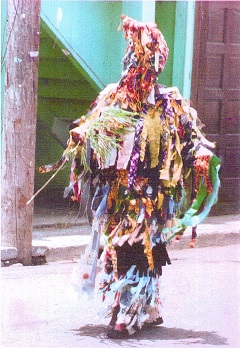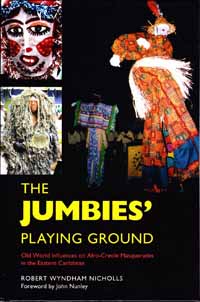Book Review: 'The Jumbies' Playing Ground: Old World Influences on Afro-Creole Masquerades in the Eastern Caribbean'
by Robert Wyndham Nicholls.
Jackson: University Press of Mississippi, 2012, 323pp.
ISBN (hardback) 978-1-61703-611-8, $55.00
ISBN (paperback) 978-1-4968-0247-7, $30.00
Rob Nicholls has produced an attractive book amply illustrated with both colour and black and white photographs, and containing an extensive collection of descriptions of masquerading and disguising customs in the Caribbean, West Africa and northern Europe. There are striking visual similarities between these customs across the continents, which beg the question; did they arise independently, or were they interconnected by, for instance, the transatlantic slave trade? If the latter, could some British customs have derived from the Caribbean or even from Africa? We know that folk drama texts were taken from England to the Caribbean, but could the enigmatic ribbon and streamer-style costumes have travelled in the other direction?
This book has an impressive number of illustrations - 65 colour and 30 black and white figures and plates. The section on costumes and masks is excellent, as it not only describes them, but also explains their manufacture and the practicalities surrounding their design, materials and use. The section on musical instruments is similarly good, especially as regards drums, although illustrations of the different drum types would have been helpful, since they are all but absent from the many figures and plates. Interestingly, Nicholls cites several examples of coloured people blackening faces in the Caribbean for disguise (e.g. pp.122 & 213)
The prime geographical focus of the book is the Anglophone Caribbean, especially the eastern islands nearer the US Virgin Islands where Nicholls is based. 'Jumbie' is a name used in the West Indies for various spirits, and their most familiar representations are the 'Mocko Jumbie' stilt dancers similar to those pictured on the book's cover. But this is just one of a wide variety of masquerading - 'mas' - customs, which include:
- Mock Jumbie (stilt dancers)
- Jonkannu (various spellings)
- Raffia Bear
- Bull
- Donkey and Horse Masquerades
- Sensay and Pitchy Patchy
- Masquerades
- Highlanders and Clowns
|
- Mother Hubbard
- Cane Cutters
- Tea Meetings
- Giant Despair
- David and Goliath
- Mummies
- Shakespeare Mas'
|
Some of these are localised, such as the Mummies of St.Kitts-Nevis and the Shakespeare Mas' of Carriacou, but others, such as the Mocko Jumbies and Jonkannu are widely dispersed throughout the Caribbean and onto the adjacent North and South American mainlands.
Nicholl's African material comes from the Upper Guinea region of West Africa - mostly the coastal peoples from Senegambia to the Niger Delta - from which the majority of Caribbean slaves were transported. This area seems to be well selected, with the chosen African masquerades appearing to be typical of the relevant sub-regions or ethnic groups. To my mind, the selection of material from Europe is more problematic. There is an understandable focus on England, but within England, there is an emphasis on the South West hinterland of Bristol, which was the country's pre-eminent slaving port. However, Liverpool vied with Bristol for this dubious accolade, and there is little or no discussion of Lancashire or Cheshire customs in this book. I am also concerned that it is inferred that certain customs are generic to England - e.g. Horn Dances and Straw Bears - when in reality they are confined to small or unique localities. This concern also applies to continental Europe. These issues may repay further research.
As may have been guessed from the foregoing, the possible origins of the Caribbean customs are discussed throughout the book. At least two of the English origins are clear cut. The Mummies play on St. Kitts and Nevis comes from a version published in Juliana Horatia Ewing's 'The Peace Egg', acquired from a local church, and the Shakespeare Mas' on Carriacou involves competitive recitation of Shakespeare's 'Julius Caesar'. What could be more English? To be fair though, only the texts are demonstrably English. The costumes and styles of presentation are something else. Also these customs are limited to two very restricted areas. More generally, Nicholls wonders if European customs could have been imported into the Caribbean by indentured servants during the early colonial period. Slaves could also have imitated the culture of their masters or even the British military, which was known for staging entertainments when times were quiet. It would have been interesting to have followed this up with a discussion of the 'Redlegs', the modern day poor white remnants of these indentured servants. They live on a par with poor blacks, but are their customs and traditions the same or different?
The parallels seem strongest between West African and Caribbean traditions. There are a couple of African candidates for the origin of the word 'Jumbie'. Nicholls suggests that stilt dancers originated from the Mandinka of Senegambia, and John Canoes (variously spelled) from Central Africa and/or the Bight of Biafra. Bush masquerades (directly comparable to shaggy bears and straw bears), horned animal masquerades and costumes made from cloth strips are fairly widespread in the Upper Guinea Region, but are also found to a lesser or greater extent in Europe. The Caribbean manifestations of these customs and costumes could have come from Africa, or could have been African-European creolisations, or they could all have arisen independently to utilise locally available materials. Nicholls helpfully states that "Creolisms can be seen as falling somewhere on a sliding scale between African and European poles", where stilt dancing is at the African end, derived from Upper Guinea, and Maypoles, quadrilles and plays such as 'St. George' and 'Goliath' are closer to the European end.
 Pitchy Patchy in the Pitchy Patchy in the
US Virgin Islands, 1995Appendix 2 - "Diaspora in Reverse" is perhaps one of the most interesting parts of the book for British and Irish folk play scholars, because it considers if Caribbean masquerades could have influenced customs back in Africa and Europe (more specifically England).
The case for New World customs going back to Africa is fairly clear cut. Both Liberia and Sierra Leone were established for freed slaves who wished to "return" to Africa. With them went garrisons of West Indian soldiers, who, in the case of Britain at least, also went on to occupy the Gold Coast - present day Ghana. These colonists took their customs with them, which then creolised with local native traditions.
The case for Caribbean or even African customs influencing British customs is more complex, with plenty of scope for further study. The close similarities between Caribbean Pitchy-Patchy masquerades and English mummers' ribbon/streamer costumes have been noted before, and raise the plausible possibility that they could have been imported to England from the West Indies (or vice versa).
I am reluctant to say anything negative about this fascinating book, but I am afraid its utility as a reference work is undermined by its extensive but frustratingly idiosyncratic index. I failed to find most of the simple things I looked for the index - islands, tribes, customs, etc. - even when there were subheadings for them within the book. Elsewhere, there are inevitably a few minor errors, which it would be churlish of me to enumerate here, although I was rather amused by the mention of "the Battle of Worcester (Gloucestershire)". Notwithstanding these issues, I have no hesitation in recommending Nicholls' book to anyone with an interest in folk drama, folk costume, or cross-cultural interactions.
Peter Millington
|

